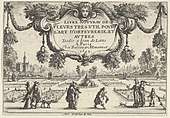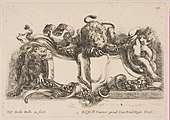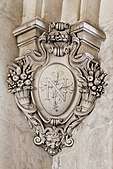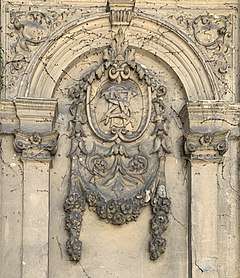Cartouche (design)
A cartouche (also cartouch) is an oval or oblong design with a slightly convex surface, typically edged with ornamental scrollwork. It is used to hold a painted or low-relief design.[1] Since the early 16th century, the cartouche is a scrolling frame device, derived originally from Italian cartoccia. Such cartouches are characteristically stretched, pierced and scrolling.
.jpg)
| Look up cartouche in Wiktionary, the free dictionary. |
Another cartouche figures prominently in the 16th-century title page of Giorgio Vasari's Lives of the Most Excellent Painters, Sculptors, and Architects, framing a minor vignette with a device of pierced and scrolling papery cartoccia.
The engraved trade card of the London clockmaker Percy Webster shows a vignette of the shop in a scrolling cartouche frame of Rococo design that is composed entirely of scrolling devices.
Gallery
 Title Plate, from Livre Nouveau de Fleurs Tres-Util, with a big Baroque cartouche, decorated with festoons, horns of abundance, and a mascaron, 1645, in the Metropolitan Museum of Art (New York City)
Title Plate, from Livre Nouveau de Fleurs Tres-Util, with a big Baroque cartouche, decorated with festoons, horns of abundance, and a mascaron, 1645, in the Metropolitan Museum of Art (New York City) Cartouche containing an empty shield surmounted by a lion and framed by a lion and a child, by Stefano della Bella, 1646, in the Metropolitan Museum of Art
Cartouche containing an empty shield surmounted by a lion and framed by a lion and a child, by Stefano della Bella, 1646, in the Metropolitan Museum of Art Etching of a cartouche framed by ducks and weeds, by Stefano della Bella, 1647, in the Metropolitan Museum of Art
Etching of a cartouche framed by ducks and weeds, by Stefano della Bella, 1647, in the Metropolitan Museum of Art Design of a cartouche, by Stefano della Bella, 1647, in the Cleveland Museum of Art (Cleveland, Ohio, US)
Design of a cartouche, by Stefano della Bella, 1647, in the Cleveland Museum of Art (Cleveland, Ohio, US) Etching of a complex cartouche, by Bernard Turreau, 1716, in the Metropolitan Museum of Art
Etching of a complex cartouche, by Bernard Turreau, 1716, in the Metropolitan Museum of Art_MET_DP834139.jpg) Frontispiece for 'Figures French and comic' (Figures francoises et comiques), by Robert Hecquet, 18th century, in the Metropolitan Museum of Art
Frontispiece for 'Figures French and comic' (Figures francoises et comiques), by Robert Hecquet, 18th century, in the Metropolitan Museum of Art The Forges of Vulcan, from the Book of Cartouches, probably by François Boucher, mid-18th century, in the Metropolitan Museum of Art
The Forges of Vulcan, from the Book of Cartouches, probably by François Boucher, mid-18th century, in the Metropolitan Museum of Art Cartouche decorated with horns of plenty, an architectural ornament of the Louvre
Cartouche decorated with horns of plenty, an architectural ornament of the Louvre._There_is_written_MDCCCXCVI_(1896).jpg)
 Cartouche with a monogram of ZNS, surrounded by Neo-Renaissance ornaments, in some kind of a Venetian window-relief, on the wall of a house from Bucharest
Cartouche with a monogram of ZNS, surrounded by Neo-Renaissance ornaments, in some kind of a Venetian window-relief, on the wall of a house from Bucharest%2C_each_door_having_the_same_thing_above_them%2C_in_Bucharest_(Romania).jpg) Neo-Renaissance ornaments above a door, in the center a cartouche, in the D.A. Sturdza House (Cărturești Verona when the photo was taken), each door having the same thing above them, in Bucharest
Neo-Renaissance ornaments above a door, in the center a cartouche, in the D.A. Sturdza House (Cărturești Verona when the photo was taken), each door having the same thing above them, in Bucharest.jpg) Cartouche surrounded by a pair of festoons made of flowers, in Bucharest
Cartouche surrounded by a pair of festoons made of flowers, in Bucharest.jpg) Neo-Baroque cartouche-window with a male mascaron, in Bucharest
Neo-Baroque cartouche-window with a male mascaron, in Bucharest- A cartouche above a Neo-Baroque door and a smaller one in its middle, in the House of Scientists (Lviv)
- Cartouche that consists of three angels with clouds surrounding them, above a door in France
 Cartouche with a caduceus, on the roof of the Crédit Lyonnais headquarters (Paris)
Cartouche with a caduceus, on the roof of the Crédit Lyonnais headquarters (Paris)
Footnotes
- Ching, Francis D.K. (1995). A Visual Dictionary of Architecture. New York: John Wiley and Sons. p. 183. ISBN 0-471-28451-3.
External links
| Wikimedia Commons has media related to Cartouches. |
